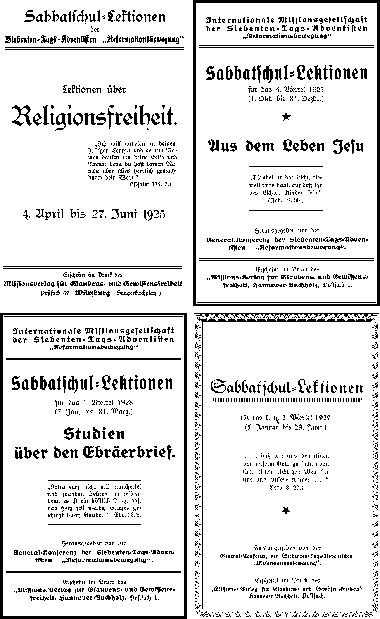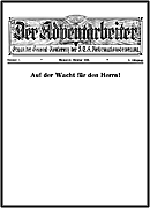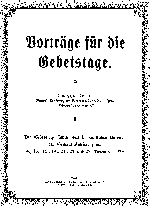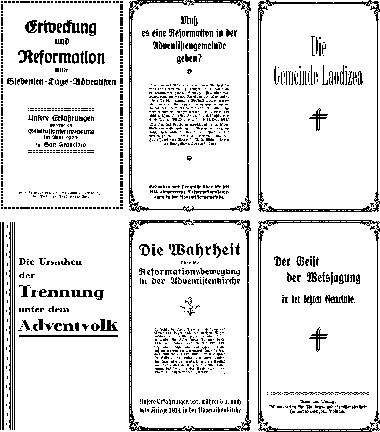Throughout our history since 1914, we have seen the merciful hand of God with us in every crisis. He has given us many victories. Hereunder are the most noteworthy events which transpired since 1921.
First Period: 1921 – 1934

1921–1925
Before the organization of the SDA Reform Movement in 1925, and especially before the meeting in Wuerzburg (1921), Reformers and so-called Reformers did a great deal of unofficial publishing. But we can identify some official publications, too.
Local Sabbath School lessons began to be published as soon as 1915. However, the earliest lessons we have in our library were published in 1922. Beginning with the fourth quarter of 1922, the first two quarterlies dealt with the book of Revelation.
The Sabbat-Waechter (Sabbath Watchman), a monthly magazine, appeared in 1920.
In 1923, Carl Spanknoebel was sent as a missionary to the USA. Also, Willi O. Welp, the son of Otto Welp, immigrated to America in the same year. Arthur W. Doerschler, Otto Welp’s son-in-law, arrived a little later. Oscar Kramer arrived in the United States in 1925.
Andrei Lavrik, from Bessarabia, Romania, went to Brazil in 1924 to do pioneering work.
1925–1928
The great concern of the Reform brethren in those days (1925–1928) was to send out missionaries and to occupy new territories.
Andrei Cecan from Bessarabia, Romania, went to Brazil in 1926 with his parents. He was a great help to Brother Lavrik. Karl (Carlos) Kozel from Germany, and Iefteni (Eugenio) Laicovschi from Bessarabia, Romania, immigrated to Argentina in 1927.
As far as the international center of operations was concerned, it was decided that the General Conference should, for the time being, share the same building where the German Union had its headquarters, in Wuerzburg. In 1926 the General Conference office was moved from Wuerzburg to Isernhagen, near Hannover, Germany, together with the German Union headquarters.

As a bigger and much more suitable place had been secured for the two headquarters (General Conference and German Union), a print shop was also set up on the same property. The establishment of the Religious Liberty Publishing Association (Missionsverlag fuer Glaubens-und-Gewissensfreiheit) permitted the development of the colporteur work, which became a very active enterprise.
After so many years have elapsed, we cannot easily distinguish between the work of the General Conference and that of the German Union in the early days of our history.
The first number of the official organ of the SDA Reform Movement General Conference–Der Adventarbeiter (The Advent Worker)–appeared in October 1928.
Reform publications that had been sent overseas and had been scattered in many places generated some response. The seed was already springing up and it was necessary to send workers to answer the Macedonian calls coming from different areas. And there were courageous men who said, through their attitude, “Here am I; send me,” showing their willingness to do pioneering work in faraway countries, where they would have to learn a new language and adapt themselves to different living conditions.
1928–1931

Soon after the first General Conference session (1925), internal difficulties began to arise; 1928 was a particularly difficult year for the work in Germany and for the General Conference administration. Wilhelm Richter, president of the German Union, was in opposition to Otto Welp, the General Conference president. During the second General Conference session (1928), the whole committee of the German Union, under the influence of Brother Richter, stood up against the General Conference administration. Albert Mueller, Joseph Adamczak and Kasper Kissener sided with Brother Richter. Brother Richter was removed from his office as president of the German Union, but his committee supported him against the decision of the General Conference. Special efforts were made to convince the German leaders to change their attitude and, after a long discussion, they finally admitted that they were in error. The leadership of the German Union was then given to Brother Mueller. But that was not the end of the trouble. The next day, Brother Richter recanted his confession and continued his opposition. He, together with some of those who continued supporting him, were disfellowshiped. For years he tried to establish his own group but was unsuccessful. During World War II, for some time, he seemed to be reconciled with the leading brethren. But toward the end of the war, he fell out with the leadership again. Disgruntled, he returned to the Adventist Church in 1945.

The General Conference was incorporated on January 11, 1929. Some of our leaders wanted to know what had become of that registration. So, in 1963, D. Nicolici, plus the author of this book and one more brother went to the registration office at Burgwedel, near Hannover, Germany, and this is what they learned: The German Union was incorporated on March 21, 1927 (this was the second incorporation); and it was dissolved by the Secret State Police May 12, 1936. The General Conference was incorporated on January 11, 1929, and dissolved by the Secret State Police May 11, 1936.
1931–1934
The work of reformation had already gained a good foothold in Europe, and, with the help of human and financial means coming from the European countries, Reform missionaries were already working in the United States, Canada, Brazil, and Argentina. Now it was necessary to answer the urgent calls coming from other parts of the world. According to a report presented by T. T. Ndhlovu, from Southern Rhodesia (now Zimbabwe), at the 1931 General Conference session, a European missionary was needed to help in the work in the southern parts of Africa. Eugen Frick, from Germany, and his wife accepted the call. Arrangements were made by the General Conference Executive Committee (meeting at Isernhagen, Germany, August 1931) for Brother and Sister Frick to move to South Africa by the end of September 1931.
Prophetic charts were needed for the work in several places. Martin Hunger, from Germany, was entrusted with the task of preparing these missionary materials.
A small missionary school had already been started at Rama, near Wuerzburg, Germany, in 1920. Yet this was a local initiative. So, during their meeting in August 1931, the Executive Committee of the General Conference decided to establish a missionary training center on an international basis for the preparation of workers for the worldwide field, in Schwaebisch Hall, Germany. The date for the beginning of the school year was set for April 1, 1932.

The Executive Committee was filled with concern regarding the preparation of young people for the work. It was evident that each Union was not in a position to establish its own missionary training center. So, the Committee decided (July 1932) to recommend the following plan to all Union Conferences: Each local church and group should function as a little school where young men and women should receive a theoretical and practical training for the work.
The Executive Committee (July 1932) still had to deal with one of the questions that had come up during the delegation session in 1931, namely, the latter rain and the loud cry. In one of their resolutions, they declared with reference to the last stage of the work of Revelation 18:1–4:
“On the basis of the Holy Scriptures and the Spirit of Prophecy writings concerning the meaning of the loud cry, and the way in which the loud cry is to come, it is our knowledge and conviction that we are not in the loud cry at this time. According to Early Writings, p. 271, it is evident that the loud cry will come together with the latter rain. However, we believe that this work of reformation is a fulfillment of Revelation 18:1 in the sense that it is preparing the way for the loud cry.”
The next General Conference Executive Committee meeting took place in Heerlen, Holland, on December 1933. Still greatly concerned with the need to enter new fields, the Committee sent the following recommendation to all Union Conferences: The leaders of the different Unions should select the most faithful and capable young men, who have already proved that they have a burden for souls and who already have a good experience in the colporteur work, and encourage them to learn foreign languages. If necessary, under special circumstances, the General Conference will cover the expenses involved in this program. As the Bible and the Spirit of Prophecy say that workers are to be sent out two and two, this plan must be taken into account by our young men when they make up their mind to start learning a language, in agreement with one another, under the guidance of the Union Committee. Then they can be sent out as colporteurs, two to one country, two to another country, and so on. Pioneering work is to be done through colporteurs.

